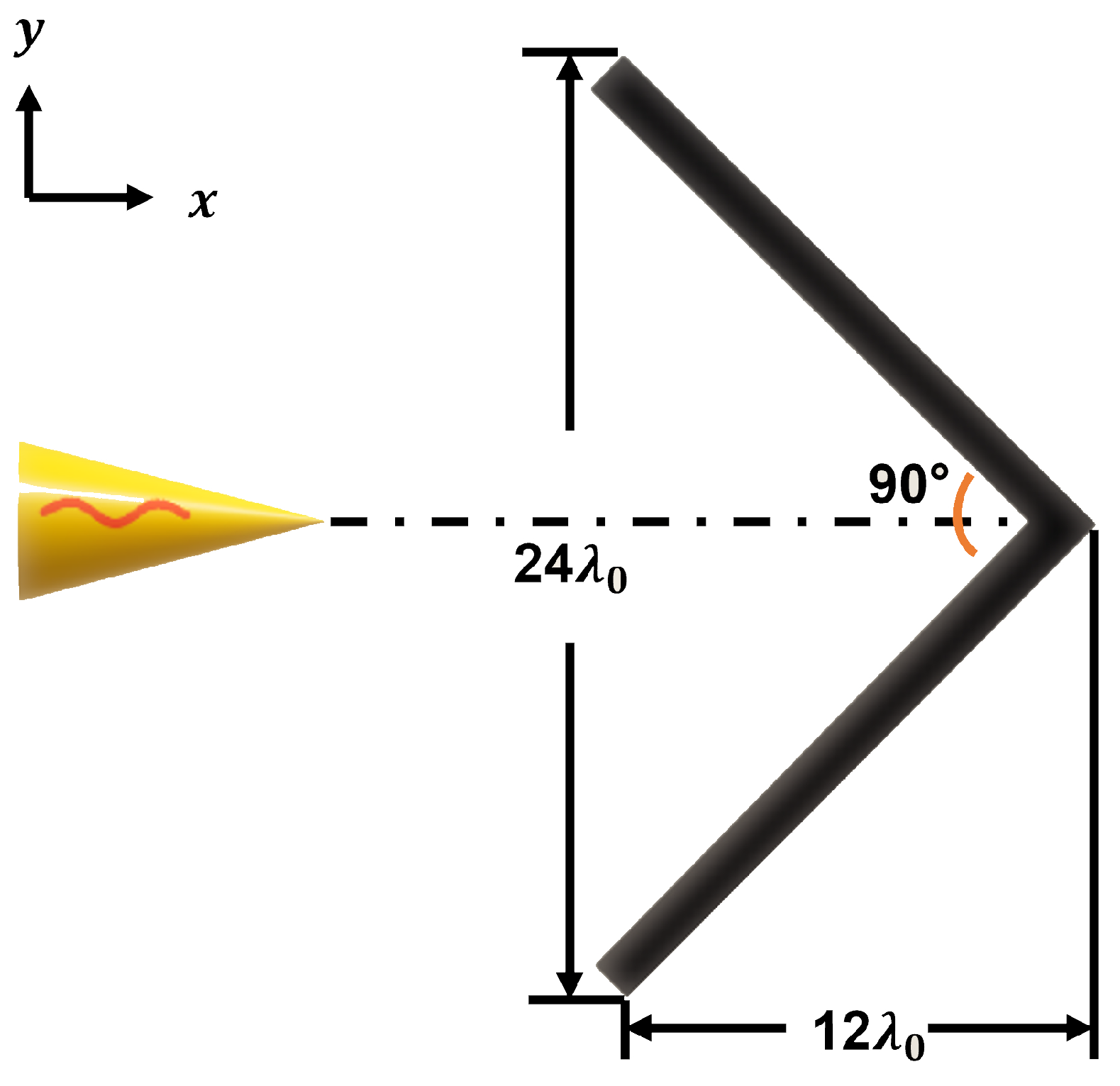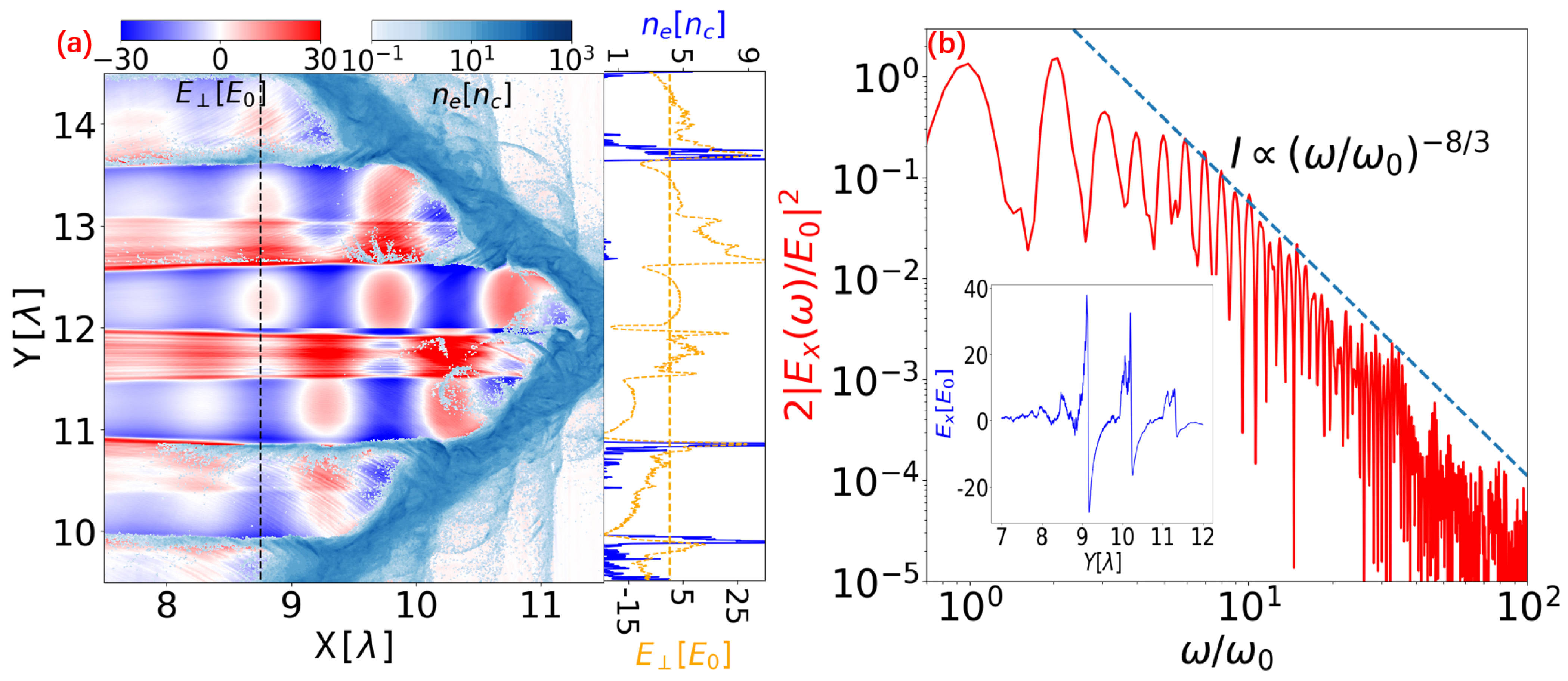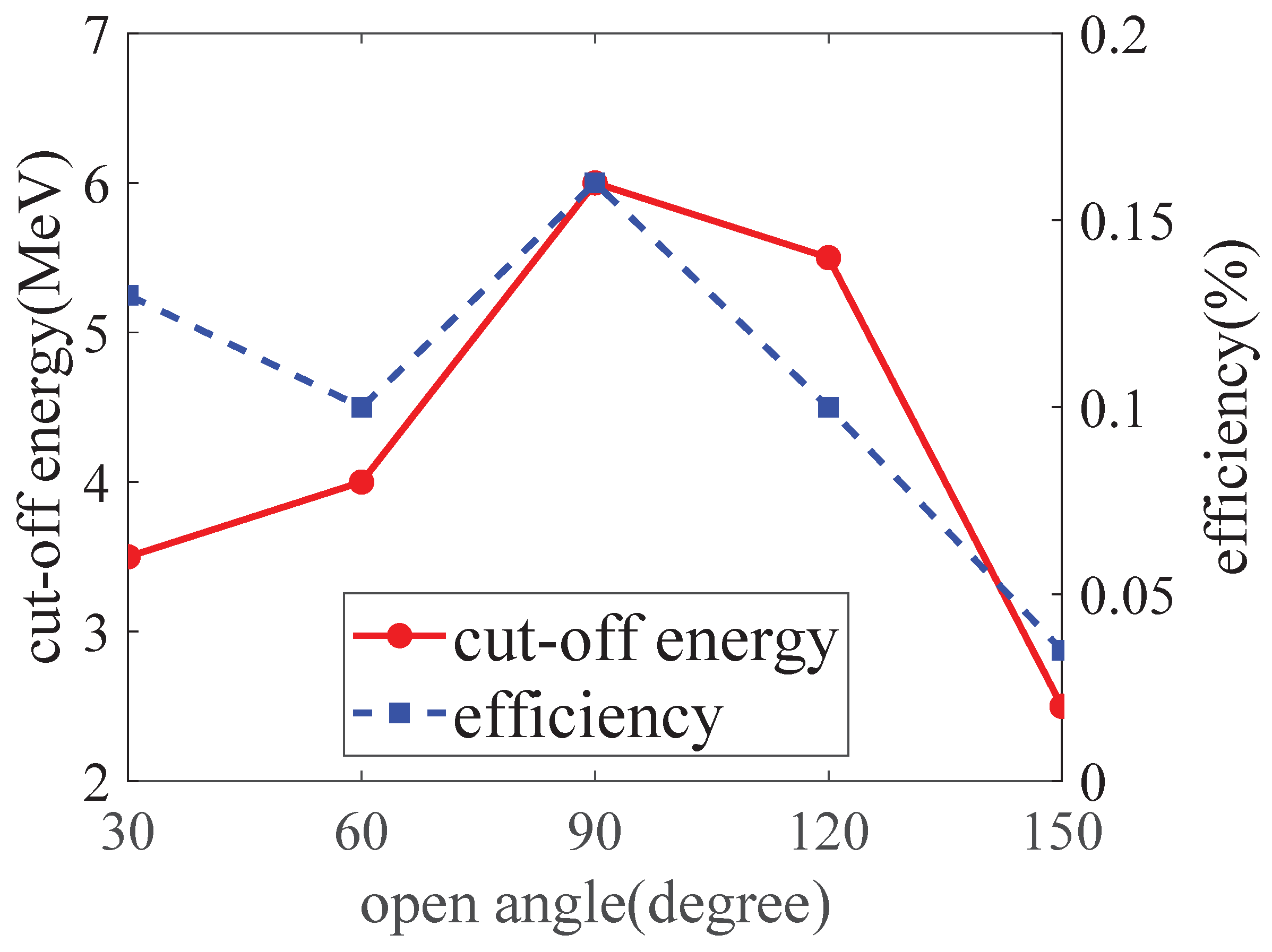Simulation Study of a Bright Attosecond γ-ray Source Generation by Irradiating an Intense Laser on a Cone Target
Abstract
:1. Introduction
2. Simulation Setup
3. Results and Discussion
3.1. Electrons Injection and Acceleration
3.2. γ-ray Pulses Generation
4. Conclusions
Author Contributions
Funding
Institutional Review Board Statement
Informed Consent Statement
Data Availability Statement
Acknowledgments
Conflicts of Interest
References
- Mourou, G.; Strickland, D. Compression of amplified chirped optical pulses. Opt. Commun. 1985, 55, 447–449. [Google Scholar]
- Hain, S.; Mulser, P. Fast Ignition without Hole Boring. Phys. Rev. Lett. 2001, 86, 1015–1018. [Google Scholar] [CrossRef] [PubMed]
- Esirkepov, T.Z.; Bulanov, S.V.; Nishihara, K.; Tajima, T.; Pegoraro, F.; Khoroshkov, V.S.; Mima, K.; Daido, H.; Kato, Y.; Kitagawa, Y.; et al. Proposed Double-Layer Target for the Generation of High-Quality Laser-Accelerated Ion Beams. Phys. Rev. Lett. 2002, 89, 175003. [Google Scholar] [CrossRef]
- Wilks, S.C.; Langdon, A.B.; Cowan, T.E.; Roth, M.; Singh, M.; Hatchett, S.; Key, M.H.; Pennington, D.; MacKinnon, A.; Snavely, R.A. Energetic proton generation in ultra-intense laser-solid interactions. Phys. Plasmas 2001, 8, 542–549. [Google Scholar] [CrossRef]
- Calegari, F.; Lucchini, M.; Kim, K.S.; Ferrari, F.; Vozzi, C.; Stagira, S.; Sansone, G.; Nisoli, M. Quantum path control in harmonic generation by temporal shaping of few-optical-cycle pulses in ionizing media. Phys. Rev. A 2011, 84, 10814–10822. [Google Scholar] [CrossRef]
- Mikhailova, J.M.; Fedorov, M.V.; Karpowicz, N.; Gibbon, P.; Platonenko, V.T.; Zheltikov, A.M.; Krausz, F. Isolated Attosecond Pulses from Laser-Driven Synchrotron Radiation. Phys. Rev. Lett. 2012, 109, 245005. [Google Scholar] [CrossRef] [PubMed] [Green Version]
- Von der Linde, D.; Rzazewski, K. High-order optical harmonic generation from solid surfaces. Appl. Phys. B 1996, 63, 499–506. [Google Scholar] [CrossRef]
- Hentschel, M.; Kienberger, R.; Spielmann, C.; Reider, G.A.; Milosevic, N.; Brabec, T.; Corkum, P.; Heinzmann, U.; Drescher, M.; Krausz, F. Attosecond metrology. Nature 2001, 414, 509–513. [Google Scholar] [CrossRef]
- Silva, R.E.F.; Rivière, P.; Martín, F. Autoionizing decay of H2 doubly excited states by using xuv-pump-infrared-probe schemes with trains of attosecond pulses. Phys. Rev. A 2012, 85, 063414. [Google Scholar] [CrossRef] [Green Version]
- Morishita, T.; Watanabe, S.; Lin, C.D. Attosecond Light Pulses for Probing Two-Electron Dynamics of Helium in the Time Domain. Phys. Rev. Lett. 2007, 98, 083003. [Google Scholar] [CrossRef] [Green Version]
- Ikeura-Sekiguchi, H.; Sekiguchi, T. Attosecond Electron Delocalization in the Conduction Band through the Phosphate Backbone of Genomic DNA. Phys. Rev. Lett. 2007, 99, 228102. [Google Scholar] [CrossRef] [PubMed]
- Kohlweyer, S.; Tsakiris, G.D.; Wahlström, C.-G.; Tillman, C.; Mercer, I. Harmonic generation from solid-vacuum interface irradiated at high laser intensities. Opt. Commun. 1995, 117, 431–438. [Google Scholar] [CrossRef]
- Von der Linde, D.; Engers, T.; Jenke, G. Generation of high-order harmonics from solid surfaces by intense femtosecond laser pulses. Phys. Rev. A 1995, 52, R25–R27. [Google Scholar] [CrossRef]
- Blanco, M.; Flores-Arias, M.T. Frequency gating to isolate single attosecond pulses with overdense plasmas using particle-in-cell simulations. Opt. Express 2017, 25, 13372–13381. [Google Scholar] [CrossRef] [PubMed]
- Quéré, F.; Thaury, C.; Monot, P.; Dobosz, S.; Martin, P.; Geindre, J.-P.; Audebert, P. Coherent Wake Emission of High-Order Harmonics from Overdense Plasmas. Phys. Rev. Lett. 2006, 96, 125004. [Google Scholar] [CrossRef]
- Dromey, B.; Kar, S.; Bellei, C.; Carroll, D.C.; Clarke, R.J.; Green, J.S.; Kneip, S.; Markey, K.; Nagel, S.R.; Simpson, P.T.; et al. Bright Multi-keV Harmonic Generation from Relativistically Oscillating Plasma Surfaces. Phys. Rev. Lett. 2007, 99, 085001. [Google Scholar] [CrossRef] [Green Version]
- An der Brügge, D.; Pukhov, A. Enhanced relativistic harmonics by electron nanobunching. Phys. Plasmas 2010, 17, 033110. [Google Scholar] [CrossRef] [Green Version]
- Sentoku, Y.; Mima, K.; Ruhl, H.; Toyama, Y.; Kodama, R.; Cowan, T.E. Laser light and hot electron micro focusing using a conical target. Phys. Plasmas 2004, 11, 3083–3087. [Google Scholar] [CrossRef]
- Liu, F.; Lin, X.X.; Liu, B.C.; Ding, W.J.; Du, F.; Li, Y.T.; Ma, J.L.; Liu, X.L.; Sheng, Z.M.; Chen, L.M.; et al. Micro focusing of fast electrons with opened cone targets. Phys. Plasmas 2012, 19, 013103. [Google Scholar]
- Wang, J.W.; Zepf, M.; Rykovanov, S.G. Intense attosecond pulses carrying orbital angular momentum using laser plasma interactions. Nat. Commun. 2019, 10, 5554. [Google Scholar] [CrossRef] [Green Version]
- Cai, J.; Shou, Y.R.; Han, L.Q.; Huang, R.X.; Wang, Y.X.; Song, Z.H.; Geng, Y.X.; Yu, J.Q.; Yan, X.Q. High efficiency and collimated terahertz pulse from ultra-short intense laser and cone target. Opt. Lett. 2022, 47, 1658–1661. [Google Scholar] [CrossRef] [PubMed]
- Tursun, A.; Bake, M.A.; Xie, B.S.; Niyazi, Y.; Abudurexiti, A. Ultrabright γ-ray emission from the interaction of an intense laser pulse with a near-critical-density plasma. Chin. Phys. B 2021, 30, 115202. [Google Scholar] [CrossRef]
- Derouillat, J.; Beck, A.; Pérez, F.; Vinci, T.; Chiaramello, M.; Grassi, A.; Flé, M.; Bouchard, G.; Plotnikov, I.; Aunai, N. Smilei: A collaborative, open-source, multi-purpose particle-in-cell code for plasma simulation. Comput. Phys. Commun. 2018, 222, 351–373. [Google Scholar] [CrossRef] [Green Version]
- Yoon, J.W.; Kim, Y.G.; Choi, I.W.; Sung, J.H.; Lee, H.W.; Lee, S.K.; Nam, C.H. Realization of laser intensity over 1023 W/cm2. Optica 2021, 8, 630–635. [Google Scholar] [CrossRef]
- Gordienko, S.; Pukhov, A. Scalings for ultrarelativistic laser plasmas and quasimonoenergetic electrons. Phys. Plasmas 2005, 12, 043109. [Google Scholar] [CrossRef] [Green Version]
- Thévenet, M.; Leblanc, A.; Kahaly, S.; Vincenti, H.; Vernier, A.; Quéré, F.; Faure, J. Vacuum laser acceleration of relativistic electrons using plasma mirror injectors. Nat. Phys. 2016, 12, 355–361. [Google Scholar] [CrossRef]
- Zhou, C.L.; Bai, Y.F.; Song, L.W.; Zeng, Y.S.; Xu, Y.; Zhang, D.D.; Lu, X.M.; Leng, Y.X.; Liu, J.S.; Tian, Y.; et al. Direct mapping of attosecond electron dynamics. Nat. Photon. 2021, 15, 216–221. [Google Scholar] [CrossRef]
- Hu, L.X.; Yu, T.P.; Shao, F.Q.; Zou, D.B.; Yin, Y. Enhanced dense attosecond electron bunch generation by irradiating an intense laser on a cone target. Phys. Plasmas 2015, 22, 033104. [Google Scholar] [CrossRef]
- Hu, L.X.; Yu, T.P.; Shao, F.Q.; Luo, W.; Yin, Y. A bright attosecond x-ray pulse train generation in a double-laser-driven cone target. J. Appl. Phys. 2016, 119, 243301. [Google Scholar] [CrossRef]
- Yu, J.Q.; Najmudin, Z.; Hu, R.H.; Tajima, T.; Lu, H.Y.; Yan, X.Q. Ultra-brilliance isolated attosecond gamma-ray light source from nonlinear Compton scattering. arXiv 2017, arXiv:1705.07075. [Google Scholar]






Publisher’s Note: MDPI stays neutral with regard to jurisdictional claims in published maps and institutional affiliations. |
© 2022 by the authors. Licensee MDPI, Basel, Switzerland. This article is an open access article distributed under the terms and conditions of the Creative Commons Attribution (CC BY) license (https://creativecommons.org/licenses/by/4.0/).
Share and Cite
Zhang, C.-W.; Zhu, Y.-X.; Lv, J.-F.; Xie, B.-S. Simulation Study of a Bright Attosecond γ-ray Source Generation by Irradiating an Intense Laser on a Cone Target. Appl. Sci. 2022, 12, 4361. https://doi.org/10.3390/app12094361
Zhang C-W, Zhu Y-X, Lv J-F, Xie B-S. Simulation Study of a Bright Attosecond γ-ray Source Generation by Irradiating an Intense Laser on a Cone Target. Applied Sciences. 2022; 12(9):4361. https://doi.org/10.3390/app12094361
Chicago/Turabian StyleZhang, Cui-Wen, Yi-Xuan Zhu, Jian-Feng Lv, and Bai-Song Xie. 2022. "Simulation Study of a Bright Attosecond γ-ray Source Generation by Irradiating an Intense Laser on a Cone Target" Applied Sciences 12, no. 9: 4361. https://doi.org/10.3390/app12094361
APA StyleZhang, C.-W., Zhu, Y.-X., Lv, J.-F., & Xie, B.-S. (2022). Simulation Study of a Bright Attosecond γ-ray Source Generation by Irradiating an Intense Laser on a Cone Target. Applied Sciences, 12(9), 4361. https://doi.org/10.3390/app12094361





